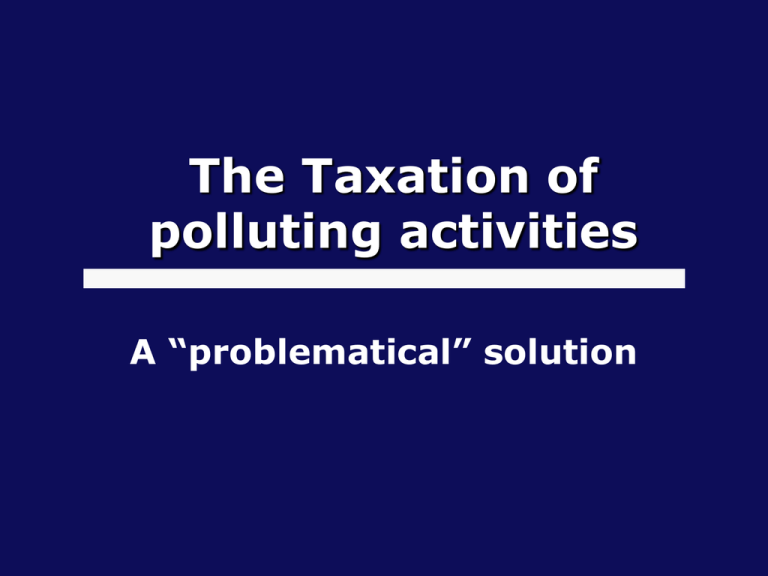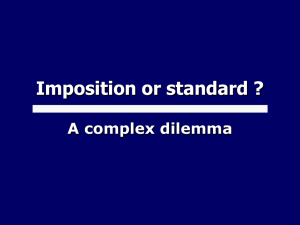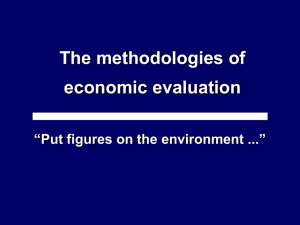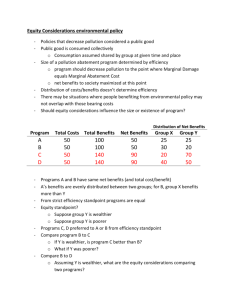eia-lesson 12
advertisement

The Taxation of polluting activities A “problematical” solution 1. THE PIGOUVIAN IMPOSE 2. THE ADVANTAGES IN COMPARISON TO THE SATANDARD SYSTEM 3. THE PROBLEM OF THE PRACTICES 3.1 The cognitive requisite 3.2 Equity 3.3 The political sustain 4. THE EFFECTS ON CONSUMERS How to tax the enterprises for the pollution they cause? Pigou (1920): To establish the tax on the base of damage estimation provoked from polluting emissions (Pigovain tax) For determining the amount of the Pigauvian tax we will determine how the environmental damage vary with the level of the produced quantity individualizing a level of perfect production socially ... ... In which marginal benefit for the enterprise and marginal cost of the society in producing a unit is equal. The Pigouvian tax is that which increase the marginal cost of the enterprise in such way to maximize the profit ! In other words, the tax transforms the social cost of the polluting to private cost of the enterprise that produces it … It is known that the value of the tax that allows reaching such result is exactly the value of the damage of polluting in correspondence of the perfect quantity ! So I require the knowledge of the exact value of the damage: In practice it is necessary to adopt approximate solutions that won’t be perfectly efficient. Fixing the tax rather than a standard level of valid production for all enterprises ... ... It is allowed to choose autonomously how to modify its proper level of production according to its really polluting potential. The results are probably a great general profit for the enterprise in the case of standard tax and therefore a great efficiency. Besides the choice of a standard level of production and therefore of emission we can not generally rely on the knowledge of the profit curves of the enterprises ... ... And therefore It will have a strong component of arbitrariness and won’t coincide socially with the perfect level ! There is then a problem of the (missed) standard: What happen if the enterprise disobey and produce more than the allowed quantity ? If the punishment is a fine of non – elevated amount ... To the enterprises it can be worthwhile to infringe until the marginal benefit of every ‘forbidden’ unit is at least equal to the value of the fine to pay ! The only way to prevent this type of behaviors is to fix the level of the fine in correspondence of that of The piggouvian tax ! But now It is worth to choose the approach based on the taxation ! And on the other hand , the fixation of a different standard from the Perfect level constitutes a loss for the society it is produced (pollutes) Because it is produced (pollutes) too little The ulterior advantages of the imposed system in comparison to the standard are: A great facilities of administration A great incentive to the containment of the pollution costs In the case of taxation an enterprise that found the way to reduce its own polluting missions with low cost would have an incentive to do it ... ... While in the case of the standard these stimulates would not exist ! Accordingly , The enterprise would be stimulated to invest in the search of less polluting technologies ! Effects of complementarities between the polluting issue: The search of technologies with minimum environmental impact can also induce the pollutants to the reduction of the emissions… ... What they produce in the chemical cycle is the same that they intend to fight ! The true problem however is: How do they evaluate exactly the cost of the pollution ? Therefore, How is the level of the tax settled down ? We need information - On the methods of production adopted by the enterprise - On the production of pollution - On the long term effects of such pollution - On the levels of human exposure to the pollution - On the consequences of such exposure in terms of physical damages - On the financial evaluation of the cost of the damage Besides, the evaluation of the benefit for the enterprise also requires a precise knowledge of their curves of questions and the structure of the private costs (non - environmental)... ... Without which it is impossible to individualize the perfect point socially! Also these information can be manipulated according to the interested parts The Pigouvian tax constitutes an application of the PIP that is also able to penalize the enterprise. We could verify political pressures to move part of the pollution costs on the society through the fixation of a bland standard as an alternative to the taxation. The problem is born from the fact, of the presence of a Pigouvian tax correctly calculated... The enterprise produces a quantity of sustainable pollution and therefore derived from the environment within reasonable limits. Accordingly, The enterprise is forced to pay for a productive activity that doesn’t produce undesirable consequences on the environment ! This can seem unfair, but on the other hand if the enterprise were forced to pay ... ... It would produce indeed a level of harmful pollution for the environment ! Similar consideration are so problematic to the political level and they often play against the adoption of the system. From the point of view of the users the tax creates a problem in how much the enterprise will have an incentive to increase the price of its production Trying to transfer the tax on the user The result is a change in the curve of offer toward the top which means a minor level of production/consumption of property ... ... Even if it is not equal to the whole amount of the tax. The effect of the tax on the users will be very strong as their demand for some property is inelastic ... ... It means that the demand for a quantity depends on low price for instance because property is ‘essential’ for some motive.




